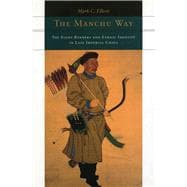
Note: Supplemental materials are not guaranteed with Rental or Used book purchases.
Purchase Benefits
What is included with this book?
|
xi | ||||
|
xii | ||||
| Preface | xiii | ||||
| Note on Transcription and Other Conventions | xxii | ||||
| Qing Reign Periods | xxiii | ||||
| Introduction. The Problem with the Manchus | 1 | (1) | |||
|
2 | (6) | |||
|
8 | (5) | |||
|
13 | (3) | |||
|
16 | (4) | |||
|
20 | (6) | |||
|
26 | (6) | |||
|
32 | (7) | |||
| PART ONE Structures of Eight Banner Society | |||||
|
39 | (50) | |||
|
39 | (3) | |||
|
42 | (5) | |||
|
47 | (5) | |||
|
52 | (4) | |||
|
56 | (7) | |||
|
63 | (9) | |||
|
72 | (6) | |||
|
78 | (11) | |||
|
89 | (44) | |||
|
90 | (3) | |||
|
93 | (5) | |||
|
98 | (7) | |||
|
105 | (11) | |||
|
116 | (6) | |||
|
122 | (6) | |||
|
128 | (5) | |||
|
133 | (42) | |||
|
134 | (4) | |||
|
138 | (8) | |||
|
146 | (6) | |||
|
152 | (4) | |||
|
156 | (4) | |||
|
160 | (4) | |||
|
164 | (11) | |||
| PART TWO Patterns of Banner Life | |||||
|
175 | (35) | |||
|
175 | (7) | |||
|
182 | (9) | |||
|
191 | (6) | |||
|
197 | (13) | |||
|
210 | (24) | |||
|
212 | (4) | |||
|
216 | (3) | |||
|
219 | (6) | |||
|
225 | (2) | |||
|
227 | (3) | |||
|
230 | (4) | |||
|
234 | (41) | |||
|
235 | (6) | |||
|
241 | (5) | |||
|
246 | (9) | |||
|
255 | (2) | |||
|
257 | (6) | |||
|
263 | (5) | |||
|
268 | (7) | |||
| PART THREE The Crises of the Eighteenth Century | |||||
|
275 | (30) | |||
|
276 | (8) | |||
|
284 | (6) | |||
|
290 | (4) | |||
|
294 | (5) | |||
|
299 | (6) | |||
|
305 | (40) | |||
|
306 | (7) | |||
|
313 | (9) | |||
|
322 | (4) | |||
|
326 | (3) | |||
|
329 | (4) | |||
|
333 | (4) | |||
|
337 | (5) | |||
|
342 | (3) | |||
| Conclusion. Manchu Identity and Manchu Rule in China | 345 | (18) | |||
|
346 | (9) | |||
|
355 | (8) | |||
| Appendix A. Note on the Size of the Eight Banner Population | 363 | (2) | |||
| Appendix B. Ranks in the Eight Banners | 365 | (4) | |||
| Appendix C. Foundation and Expansion of Provincial Garrisons | 369 | (4) | |||
| Notes | 373 | (132) | |||
| Chinese Character Glossary | 505 | (6) | |||
| References | 511 | (40) | |||
| Index | 551 |
The New copy of this book will include any supplemental materials advertised. Please check the title of the book to determine if it should include any access cards, study guides, lab manuals, CDs, etc.
The Used, Rental and eBook copies of this book are not guaranteed to include any supplemental materials. Typically, only the book itself is included. This is true even if the title states it includes any access cards, study guides, lab manuals, CDs, etc.